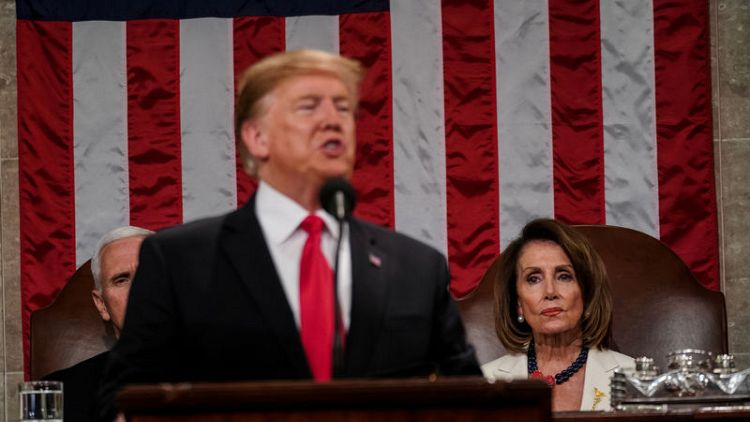By James Oliphant and John Whitesides
WASHINGTON (Reuters) - Even as he appealed for unity, President Donald Trump made it clear in his State of the Union address on Tuesday that his idea of common ground is having Democrats back his policy agenda and stop investigating his administration.
For all of Trump's talk about bridging "old divisions" and pursuing bipartisan initiatives, Trump previewed the well-trod themes that will power his 2020 re-election campaign: a hard line on immigration and border security, a deep suspicion of trade deals, and an "America First" foreign policy.
This time, the dissonance between Trump's words and the political reality was more jarring than ever. For the first time in his presidency, Trump had a Democrat seated behind him in the House chamber, Speaker Nancy Pelosi, and spoke to a Congress where Democrats share power with Republicans.
Beyond Capitol Hill, the field of Democrats seeking to challenge Trump for the presidency is growing by the week.
The speech suggested that Trump, while talking up such lofty bipartisan goals such as combating HIV and childhood cancer, was signalling to his most passionate supporters that he was not about to compromise on the issues that matter most to them.
"While there were many unifying moments, the president took time to appeal to his base over issues that split the parties such as investigations, immigration and abortion," said Ron Bonjean, a longtime Republican strategist in Washington.
"Nothing has changed after tonight's delivery by Trump because both sides are simply too dug in to allow any sort of major compromise legislation to occur," Bonjean said.
Fresh off a month-long partial government shutdown that damaged him politically, Trump showed no inclination he would back off his demand for more than $5 billion for a barrier along the U.S border with Mexico — and in fact used a large portion of the speech to make his case for the wall to the American people.
In doing so, Trump employed much of same rhetoric he used during last year's congressional elections, warning of an "onslaught" of migrants from Central America, labelling the border "lawless" and declaring that "countless" Americans had been murdered by illegal immigrants.
For a reminder of how his party fared in those midterm elections, Trump only had to look at the sea of white outfits worn by Democratic women in attendance on the House floor. They chanted "USA! USA!" when Trump recognised their achievement.
Regardless, Trump delivered a stark warning to Democrats such as Pelosi who have said they will push to hold his administration accountable: Back off, or I won’t work with you.
"If there is going to be peace and legislation, there cannot be war and investigation," Trump said. "It just doesn't work that way."
And in talking about the vibrant American economy, Trump implied he would be quick to blame Democrats for any slowdown.
CULTURE WARS
Trump also re-stoked America's culture wars, spending a portion of the speech blasting abortion-rights legislation in New York and Virginia, a move that will endear him to evangelical voters.
"There was very little difference between this speech and what you'd hear at one of his campaign rallies," said Doug Thornell, a longtime Democratic congressional aide.
"To many people this speech will be remembered for his continued obsession with the wall, the demonization of immigrants, and his bizarre attack on congressional investigations. Truly stunning."
But Alex Conant, a former top aide to Republican presidential candidate Marco Rubio, said that Trump succeeded in showing that he was open to working with Democrats on issues such as prescription drug prices.
"After a tough couple of weeks, this was the reset that Trump needed," Conant said. "He laid out a popular agenda and framed the big political issues of the day in the most favourable way possible."
There are clear signs that the showdown over the border wall has dinged the president: The most recent Reuters/Ipsos tracking poll had Trump's approval rating at a shade over 39 percent, the lowest it has been since early last October.
The number of Americas who disapprove of Trump’s job performance stood at more than 56 percent.
With Trump's re-election campaign set to begin in earnest, the president must also await the final determination of Special Counsel Robert Mueller, who is investigating ties between Trump's campaign team and Russian officials as well as possible obstruction of justice.
A year ago, Trump made a similar plea for bread-breaking with Democrats, only to have the year swallowed up by scorched-earth congressional elections, a divisive fight over Supreme Court nominee Brett Kavanaugh, and finally the 35-day government shutdown.
All the while, Trump regularly blasted Democrats on his Twitter feed as unhelpful, obstructionist and unpatriotic.
"There is no reason to think he wants unity. He thrives on disunity," said John Geer, an expert on public opinion at Vanderbilt University. "The president may call for working together, but past behaviour suggests otherwise."
(Reporting by James Oliphant and John Whitesides; Editing by Sonya Hepinstall)
